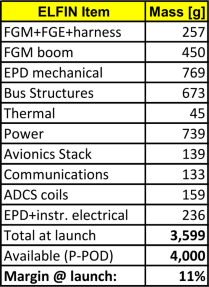Systems
ELFIN’s system engineering team played a top-level role in the design, implementation, testing, and assembly of the ELFIN CubeSats.
Requirements
ELFIN has been a mission 10 years in the making. It is ambitious and complex. In order to ensure mission success, all requirements have been organized into the Mission Requirements Document (MRD). This document organizes the traceability and flow down of all mission requirements. There are 306 requirements, 221 of which are specific to the spacecraft themselves. Each subsystem is in charge of validating their requirements, and you can see the breakdown here.
Most of the spacecraft requirements are satisfied, with only 21 being working on now.
Budget
There are five resource budgets for ELFIN; Mass, Power, Link, Data Volume, and Pointing Error. The systems team is responsible for maintaining the Mass, Power, and Link budgets.
Mass Budget
Mass
Our mass budget is used to validate that ELFIN is within the required mass of 3.4 +/- 0.417 kg. This requirement comes from out Launch Service provider. This was critical in the design phase, and now we use it now to refer to the mass properties of ELFIN A and B. We broke it down by subsystem, and during our flight integration we took measurements of individual components and integrated subsystem. The as built refers to measurements of the mass of entire subsystem assemblies while the CBE is a sum of its parts. Both ELFIN-A and ELFIN-B are within the required mass and only slightly deviate from one another.
Power
Because our spin plane nominally aligns with the orbital plane, our power production is based on beta angles. At our worst case scenario, beta 0, we only have our Y face partially illuminated. We are spinning about our XY plane, and our stacer boom will be shadowing some cells. Also at that beta angle we also have the longest eclipse time. As beta angle increases from 0, our Z face cells will be more and more illuminated, providing us more power. Our power consumption is based on operational modes. Each mode has different time-on-per-orbit based on beta angles.
This plot shows our power produced for different beta angles. We subtracted the power needed for idle as that is needed to be on at all times. As you can see, for low beta we have just enough for keeping our batteries warm enough. When we get to Beta 15 we have more power to play with and can do normal communications and some science modes. As we get to Beta 33 we are able to do full science mode. And when we get even high to 50 we have a lot of power to play with. We are within allocated power for all beta scenarios, and for most beta angle we have more power to play with. As you can see here, we are power positive on all beta orbits. Our current best estimates come from our FM TVAC campaign, with some values still being reviewed.
Link
The link budgets are used to ensure our communications system design will be functional for all intended communications events. Both the uplink and downlink are closed, meaning we can talk with ELFIN! Some values are still being determined through simulation and analysis, so we left those as conservative estimates until those values are finalized. More detail about the simulations and tests underwent to determine these values can be seen on our Communications Page.
Link Budget coming soon.
Power Budget [click to enlarge]
Risk Matrix [click to enlarge]
Assembly
In the beginning of 2018, we were faced with the assembly of three ELFINs: FMA, FMB, and EM3. EM3 is our last engineering model campaign, and we needed to put it together for vibe shock. We did a V/S campaign for our very first engineering model, but EM1 did not contain a functional payload. With this challenging task, we took a staggered parallel approach of assembly. The same personnel that would build EM3 subassemblies would build FMA and FMB. EM3 was the pathfinder: they would follow a procedure for EM3, and edit it when needed so it was perfected for FM. Each model encountered different issues, and many issues required partial disassembles. After each issue was found, we would test all models to make sure that issue was resolved across all three.
Testing
Throughout the entirety of ELFIN’s lifespan, there were many, many tests performed. Each test had its own objective, but all were needed to ensure the final design was the best for the mission. All components were tested individually, but a large amount of the tests were of integrated systems. A brief flowchart of all major integrated test campaigns since CDR of February of 2016 can be seen here.
UVF and Risk Matrix
Despite our best efforts, ELFIN STAR will by flying with some Unverified Failures (UVFs). We studied these to the best of our abilities, and ran risk analysis to see how much of an impact they would have on the mission. Thankfully, all 5 of these UVFs are low risk to the mission, as you can see in the risk matrix below.




